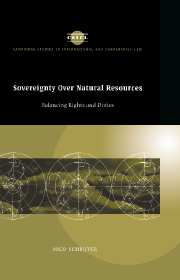Book contents
- Frontmatter
- Contents
- List of boxes, figures and tables
- Preface
- Acknowledgments
- List of abbreviations
- List of main symbols used in UN documents
- Glossary
- Table of cases
- 1 Introduction
- PART I The birth and development of the principle: the UN General Assembly as midwife
- PART II Natural-resource law in practice: from creeping national jurisdiction towards international co-operation
- Introductory remarks to Part II
- 6 International investment law: from nationalism to pragmatism
- 7 The law of the sea: extension of control over marine resources
- 8 International environmental law: sovereignty versus the environment?
- PART III Balancing rights and duties in an increasingly interdependent world
- Appendices
- Bibliography
- Index
- Books in the series
Introductory remarks to Part II
Published online by Cambridge University Press: 23 October 2009
- Frontmatter
- Contents
- List of boxes, figures and tables
- Preface
- Acknowledgments
- List of abbreviations
- List of main symbols used in UN documents
- Glossary
- Table of cases
- 1 Introduction
- PART I The birth and development of the principle: the UN General Assembly as midwife
- PART II Natural-resource law in practice: from creeping national jurisdiction towards international co-operation
- Introductory remarks to Part II
- 6 International investment law: from nationalism to pragmatism
- 7 The law of the sea: extension of control over marine resources
- 8 International environmental law: sovereignty versus the environment?
- PART III Balancing rights and duties in an increasingly interdependent world
- Appendices
- Bibliography
- Index
- Books in the series
Summary
The principle of permanent sovereignty over natural resources developed through the political organs of the United Nations, but it was given flesh and blood in the practice of international relations. Third World States invoked it in their offensives against the application of traditional international law principles such as pacta sunt servanda, freedom of the high seas and State responsibility. In addition, it was part and parcel of the same movement that gave rise to new principles and concepts such as: a fundamental change of circumstances (clausula rebus sic stantibus); participatory equality of developing countries in international economic consultation and decision-making; preferential treatment of developing countries in international trade and financial relations; entitlement of developing countries to development assistance; common heritage of mankind in the law of the sea and outer space; and common concern and ‘common but differentiated responsibilities’ in international environmental law.
Permanent sovereignty over natural resources initially played a pivotal role in efforts of developing countries to achieve ‘sovereign equality’ and often had – and still has – a protective function as a legal shield against infringement of their sovereignty by other States and foreign enterprises. This particular background and the qualification of permanent sovereignty over natural resources as ‘permanent’ and ‘inalienable’ stood for some time in the way of reshaping the principle to accommodate the realities of economic and environmental globalization.
- Type
- Chapter
- Information
- Sovereignty over Natural ResourcesBalancing Rights and Duties, pp. 171 - 172Publisher: Cambridge University PressPrint publication year: 1997

